It’s possible to create an organized homeschool space in a common room without it looking like a classroom! Here is how this mom makes her dining room into a functional homeschool space while keeping the room relaxing and inviting!

Every year I share what our homeschool space looks like, because every year it changes a little! Furniture gets rearranged in the room or just completely taken out. New pieces are built and purchased. And new homeschool and family dynamics inspire new organization solutions!
Because I love to get a peek into other people’s homeschool spaces (if you invite me over and I seem nosy, you’ve been warned), I invited a few blogging friends to share their spaces with me. (Again, nosy. I just wanted to see what they do, and now you get to see too!). You can find links to their blogs and even a few video tours at the bottom of this post.
But first, a guided tour of our homeschool space, conveniently located in our dining room.
Prefer a video tour? You can watch one here!


(curious minds want to know…our pet corn snake, Severus, is residing in that terrarium)
I always dreamed about a dedicated homeschool room in our house. A place to hang posters and artwork. A room for copious amounts of books. A room with a door to hide the daily mess!
However, the longer I homeschool, the less I think I would actually be happy with a dedicated homeschool room. Especially since in our house, that would mean homeschooling in the basement.
I actually LOVE where we do our schoolwork now. Our dining room has the best light in the house, our table is HUGE and can accommodate all of us working and playing, and thanks to a little organization, it doesn’t look like a classroom when you walk into our house.
Plus, our homeschool space is in the center of all our daily action. We can overflow onto couches for read-alouds. The toddler and preschooler can set up play spaces on the rug or a bench. The big kids can keep working while I take care of something in the kitchen or change a diaper on the floor, still supervising and answering questions the whole time.

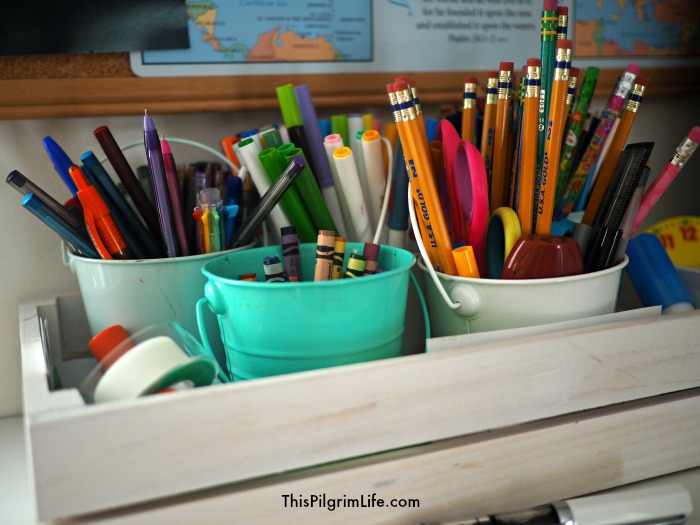

It is NOT necessary to have an amazing, Pinterest-perfect, homeschool space. But, if I can let you in on a little secret, creating a space that feels welcoming, comfortable, and even pretty to look at is sooooo helpful. After all, if you homeschool your children, you will likely spend a LOT of time in that space. Make creating a space you enjoy being in a priority.
Spending a lot of money on fancy organization supplies isn’t necessary though. Always try to work with what you have first (remember, a can of paint can go a long way in pulling everything together!) and find solutions that work for your particular space. And never be afraid to change things up a little if what you first decide needs some tweaking!
Next, I’m going to give you a closer look at what is hiding in all those baskets, how I make this space work for us, and throw out a handful of tips for keeping an organized, pleasant homeschool space in a common room without having it take over the look and feel of your house.
So let’s keep moving along on this part of the tour!
How to Create an Organized Homeschool Space in a Common Room (Without Looking Like a Classroom!)
1. Neutral Colors
Choose colors that match and blend in with what is already in your common room. For me, that’s plenty of whites and a little gray too.
Too many colors can be overwhelming and is a quick way to make your space look more like a fun classroom than a relaxing home environment. There’s nothing wrong with wanting the look of a fun classroom, but if you want to be able to put everything away and still have a space that looks more like a dining room or living room, then keep the colors toned down and coordinated.


A white bench, white storages shelves, and a majority of white baskets match the wall and help to unify the space, making it appear like there is less there.
(The storage cube and baskets are from Target, and the benches were handmade by my husband from inexpensive plywood. The chalkboard & corkbboard were thrift finds for a dollar each.)
2. Closed Storage
Similar to the tip above, opt for storage solutions that hide what they contain. Pretty baskets and wooden boxes can be appealing to look at, but too much open storage can give an appearance of clutter and messiness.
I have found that finding baskets and boxes that almost completely fill the opening in the space to be both an effective use of space, and a good way to conceal the contents of math manipulatives, games, workbooks, etc.

The gray baskets on the storage cube hold my children’s school books. One for my second grader, and one for my kindergartner. I like being able to pull the basket off the shelf and set it on the floor next to me so that I can just pull out and put away books as needed.
The white baskets hold math manipulatives on the bottom, and learning games on the top. The easy access makes it convenient for anyone to get out what they need. (The counting bears are pulled out constantly to use with ALL my kids for learning and playing!)
The center basket (not pictured) holds my Bible, planners, current books I’m reading, and so on. Because I usually start my day at the table, it is a convenient place to keep all these things.
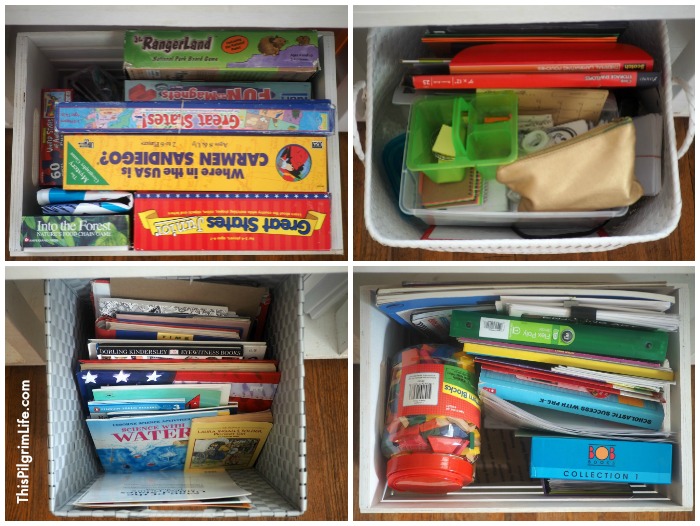
The larger baskets and boxes hold items which are used less frequently than those on the storage cubes. More games, my supplies, extra school books, and a few more manipulatives and resources, are all kept under the bench where we can get to them when we need them, but are out of sight and out of the way.
(Tip: gluing felt to the bottom of the baskets and boxes helps them to slide much more easily on the wood).
3. Be Selective
Before this school year started, I did a MAJOR purge of our school supplies. It is so easy to accumulate resources, books, and games– especially when people know you homeschool and want to generously pass on all kinds of materials to you!
However, too much stuff equals unnecessary clutter and stress. Only keep what you know you know you will use. If you are unsure of something, pack it away for a while, but don’t give it priority and precious storage space in your room.
I was holding on to so many manipulatives and workbooks and such that I NEVER used! Giving them away felt like a huge weight off.
4. Hide Boards & Posters
I don’t want too many school-related posters on my wall. I do have one wall with educational wall-art, but I want to keep the walls you see when you walk in (mostly) clear of homeschool things. I have other art on the walls that I do not want to take down.
Instead, I keep our dry erase calendar behind a curtain, and store a large cork board and map behind the couch in the dining room. I can pull them out when I need to, but they don’t stay out all the time.
 Can you spot my calendar?
Can you spot my calendar?
I try to be picky about the posters I do display. I want the quotes to be meaningful and the art to match our space. (I will say, though, that I don’t love the idea of permanently displaying our timeline in the dining room, but I haven’t figured out another place to put it. At least it’s white!)
5. Prioritize Function
Without negating everything I just said, your homeschool space has to work for YOU or it will be a source of frustration and will take away from the peaceful of your space.
When you are organizing your supplies, give priority to the materials you will use daily. Make sure that your children can access them as well, so that you are not the only one who can fetch a new pencil or gluestick or nature guide. (Alternately, you might also want to make sure that certain children DON’T have access to the markers, pens, scissors, etc!)

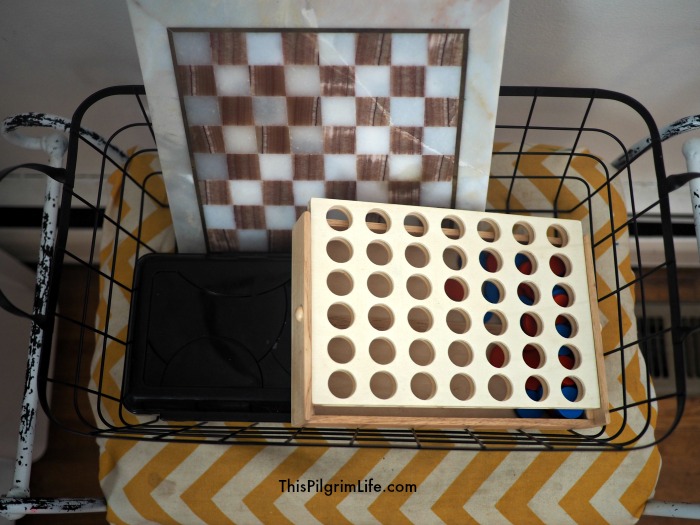 Chess and Connect Four are kept low for all the kids to play with!
Chess and Connect Four are kept low for all the kids to play with!
The saying “out of sight, out of mind” can definitely apply here, so I want to finally mention that keeping certain things in plain sight help me to think of them, and help the children to want to pull them off the shelf to use them.
I want to be better about making time to paint and draw this year (it’s a personal hobby of mine, too, that I rarely do), so I put the supplies in a pretty basket and set them right where I can see them.
All our nature guides and many of our morning time resources are also kept where we can all see them. I have found that doing this really does encourage my kids to pick up our favorite books and guides more frequently.

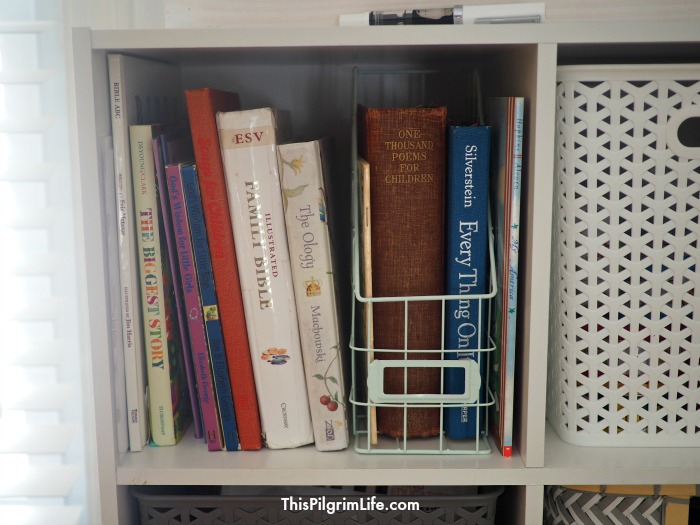

I hope that you have enjoyed this year’s tour of our homeschool space! You can check out last year’s tour here and our space from two years ago here. If you homeschool, I’d love to hear about where you do your schooling, and how you make it work!
Don’t forget to check out these other bloggers’ spaces too!
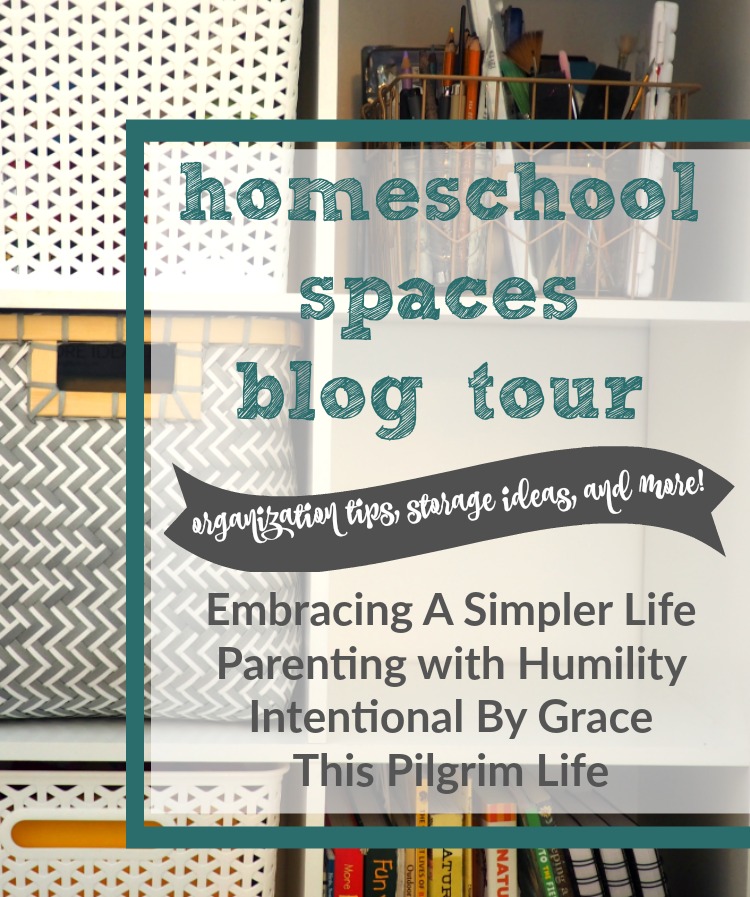
Intentional By Grace via YouTube
Want even more homeschool inspiration?
THE LINKS ABOVE MAY ALSO BE AFFILIATE LINKS, MEANING I EARN A SMALL COMMISSION AT NO EXTRA COST TO YOU. I APPRECIATE YOUR SUPPORT OF THIS SITE!




Hi Lisa,
I have to agree with you that it is more important to create a space that is welcoming, comfortable, functional yet still beautiful. It is not always about the expensive things. I don’t do homeschooling, but my boys have a place where we do most of their homework, school projects and/ study area. It’s comfortable and functional, and that is what’s important to me. And yes, I love baskets as a decorative-organizational tool 🙂
Thanks for sharing 🙂
Cheers,
Jessica